Content for TS 23.228 Word version: 18.6.0
1…
3…
4…
4.2.4…
4.3…
4.4…
4.13…
4.16…
5…
5.2…
5.3…
5.4…
5.4.7…
5.4.8…
5.4a…
5.5…
5.5.3…
5.6…
5.6.3…
5.7…
5.7.3…
5.7.5…
5.7.8…
5.8…
5.10…
5.11…
5.11.3…
5.11.3.3
5.11.3.4
5.11.4…
5.11.5…
5.11.5.3…
5.11.6…
5.12…
5.16…
5.16.2…
5.19…
5.20…
A…
E…
E.2.2…
G…
G.5…
H
I…
J…
K…
L…
M…
M.3…
N…
P…
Q…
Q.2.5…
R…
S…
T…
U…
U.2…
V…
W…
X…
Y…
Z…
AA…
AA.3…
AB…
AC…
AC.7…
AC.7.2…
AC.7.2.2
AC.7.2.3…
AC.7.4…
AC.9…
R Distribution of Network Provided Location Information within IMS
R.1 General
R.2 Session Establishment/Modification at Mobile Origination - Location Info in Request
R.3 Session Establishment/Modification at Mobile Origination - Location Info in Response
R.4 Session Establishment/Modification at Mobile Termination
R.5 Session Establishment/Modification - Location Information Distributed by IMS AS
R.6 Session Release
...
...
R Distribution of Network Provided Location Information within IMS |R11| p. 296
R.1 General p. 296
This annex describes how the user location and/or UE Time Zone information can be further distributed to IMS entities once it has been retrieved by either P-CSCF or an IMS AS. The exact mechanism for how the user location and/or UE Time Zone information are obtained is not described in this annex.
Information related to the location of the user provided by the access network may be required in IMS in order to comply with regulatory requirements (e.g. data retention, lawful interception) and/or in order to enable certain types of added value services based on the user's location.
To simplify the information flows, the IMS AS shown in the figures can represent several AS's. The CSCF represents the I-CSCF and/or the S-CSCF.
For the P-CSCF case in the originating side, the P-CSCF can, depending on operator policy, retrieve the user location and/or UE Time Zone information either before sending the INVITE towards the terminating side or upon reception of the SDP answer from the terminating side.
The transfer of the user location and/or UE Time Zone information within IMS signalling does not affect the transfer of any UE provided user location information. User location and/or UE Time Zone information provided in the signalling by the network will be distinguished from user location information provided by the UE.
R.2 Session Establishment/Modification at Mobile Origination - Location Info in Request p. 296
This information flow shows the procedure when operator policy requires the user location and/or UE Time Zone information to be included within IMS session establishment/modification signalling before sending the INVITE towards the terminating side.
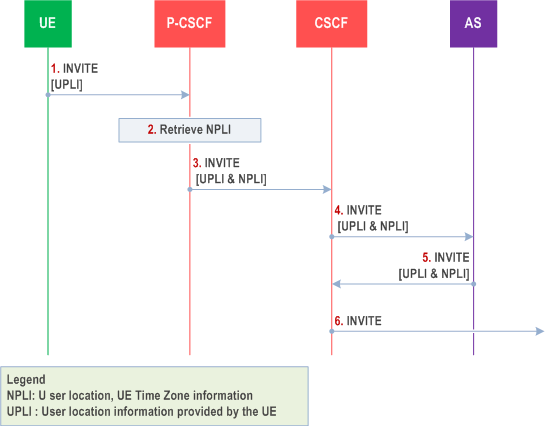
Step 1.
The UE sends a SIP INVITE request. It can contain user location information provided by the UE.
Step 2.
The P-CSCF obtains the user location and/or UE Time Zone information from the access network.
Step 3.
The P-CSCF includes the user location and/or UE Time Zone information obtained from the access network and sends the INVITE towards the next hop together with the user location information provided by the UE.
Step 4.
If an AS is to be invoked for this session, the S-CSCF (or I-CSCF) sends the INVITE towards the AS, including the user location and/or UE Time Zone information (assuming the AS is in the same trust domain).
Step 5.
The AS sends the INVITE towards the S-CSCF, still containing the user location and/or UE Time Zone information.
Step 6.
The S-CSCF routes the INVITE towards the terminating side. The user location and/or UE Time Zone information may be removed or modified (e.g. to change location granularity to just indicate the serving PLMN) before routing outside the trust domain.
R.3 Session Establishment/Modification at Mobile Origination - Location Info in Response p. 298
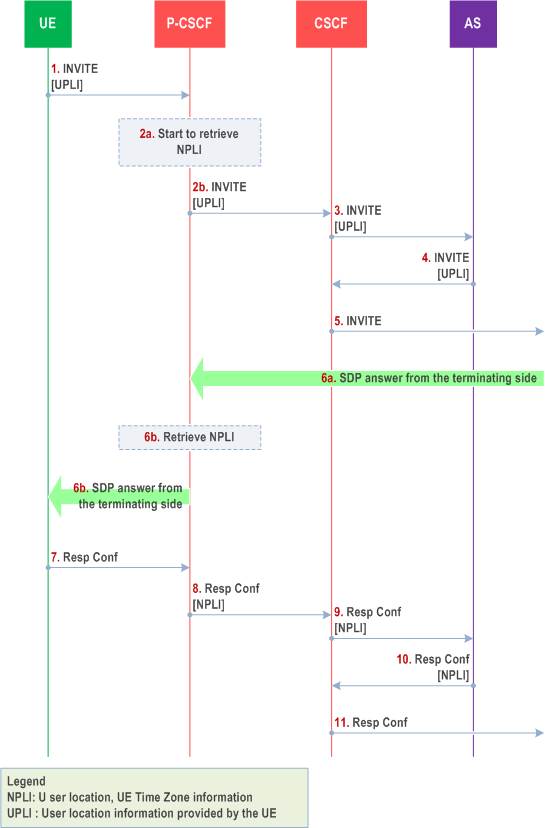
Step 1.
The UE sends a SIP INVITE request. It can contain user location information provided by the UE.
Step 2a.
Optionally, the P-CSCF may start procedures to obtain the user location and/or UE Time Zone information from the access network at reception of SDP Offer in parallel with steps 2b to 7.
Step 2b.
The P-CSCF sends the INVITE towards the next hop.
Step 3.
If an AS is to be invoked for this session the S-CSCF (or I-CSCF) sends the INVITE towards the AS.
Step 4.
The AS sends the INVITE towards the S-CSCF.
Step 5.
The S-CSCF routes the INVITE towards the terminating side.
Step 6a.
The P-CSCF receives an SDP answer sent by the terminating side.
Step 6b.
If the P-CSCF did not initiate procedures to obtain the user location and/or UE Time Zone information from the access network at step 2a, it will initiate them. This step will be executed together with Authorization of QoS resources.
Step 6c.
The P-CSCF forwards the SDP answer to the UE.
Step 7.
The UE provides a response confirmation towards the P-CSCF.
Step 8.
The P-CSCF inserts the user location and/or UE Time Zone information provided by the access network in the response confirmation, and this is routed towards the terminating side in steps 9 - 11. The user location and/or UE Time Zone information may be removed or modified (e.g. to change location granularity to just indicate the serving PLMN) before routing outside the trust domain.
R.4 Session Establishment/Modification at Mobile Termination p. 299
This information flow shows the procedure when operator policy requires the user location and/or UE Time Zone information from the access network to be included within IMS session establishment/modification signalling before sending the response towards the originating side.
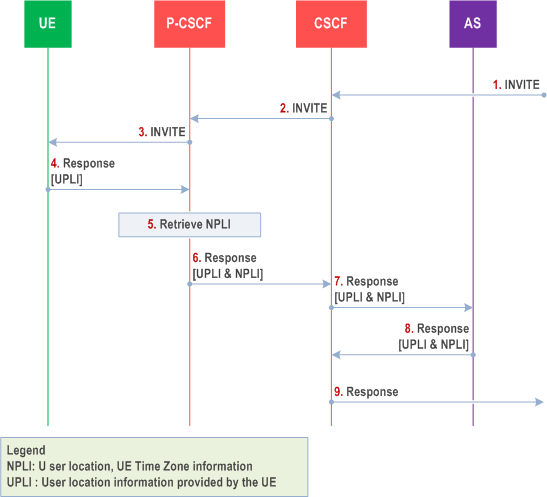
Step 1.
The CSCF receives an incoming INVITE.
Step 2.
The CSCF send the INVITE to the P-CSCF.
Step 3.
The P-CSCF sends the INVITE to the UE.
Step 4.
The UE sends a response to the INVITE (the response can be either a provisional or final response). This can contain user location information provided by the UE.
Step 5.
The P-CSCF invokes procedures to obtain user location and/or UE Time Zone information from the access network. This step will be executed together with Authorization of QoS resources. In some scenarios, it might be possible to obtain or at least initiate the fetching of user location and/or UE Time Zone information already at step 3.
Step 6.
The P-CSCF adds the user location and/or UE Time Zone information obtained from the access network and sends the response towards the next CSCF, together with the user location information provided by the UE (if available).
Step 7-9.
The response is routed towards the originating party. The user location and/or UE Time Zone information may be removed or modified (e.g. to change location granularity to just indicate the serving PLMN) before routing outside the trust domain.
R.5 Session Establishment/Modification - Location Information Distributed by IMS AS p. 300
The call flow in this clause describes the procedures to distribute user location and/or UE Time Zone information provided by the network within IMS session establishment/modification signalling when the retrieval of user location and/or UE Time Zone information is performed by an IMS AS.
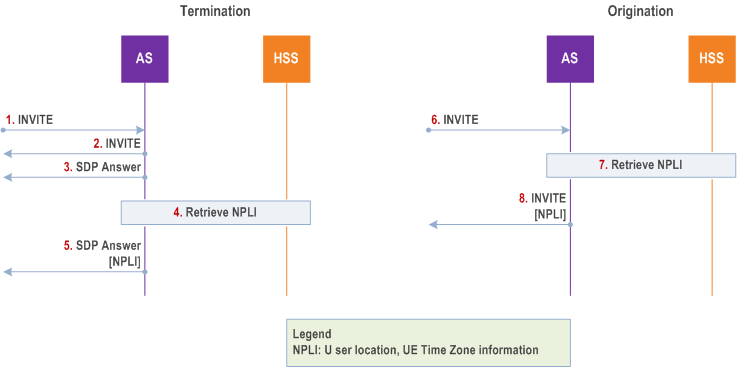
Terminating Side:
Step 1.
Originating Side:
A SIP INVITE request is received bv an AS.
Step 2.
The INVITE is processed by the AS and returned to the S-CSCF.
Step 3.
The SDP Answer is received by the AS.
Step 4.
The AS retrieves user location and/or UE Time Zone information from the access network via the HSS.
The HSS retrieves the requested information from the Access Network
The HSS/UDM may not be aware whether the UE is currently camping on 3GPP or Non 3GPP access and may need to request Location Information from the AMF, the MME, the SGSN and from the TWAN (via the AAA server in this last case).
The HSS provides the AS with the requested information. When the HSS has received multiple user location (from multiple access: 3GPP and non 3GPP), the HSS provides the AS with the most recent user location.
Step 5.
The AS includes the user location and/or UE Time Zone information obtained from the access network via the HSS and sends the SDP answer towards the S-CSCF.
Step 6.
A SIP INVITE request is received by an AS.
Step 7.
The AS retrieves user location and/or UE Time Zone information from the access network via the HSS. The same procedures as described in steps 4a and 4b above apply.
Step 8.
The AS includes the user location and/or UE Time Zone information obtained from the access network via the HSS and sends the INVITE towards the S-CSCF.
R.6 Session Release p. 301
The call flows in this clause present the mobile or network initiated IMS session release for both the Mobile Originating (MO) side and the Mobile Terminating (MT) side valid when either P-CSCF or an IMS AS retrieve user location and/or UE Time Zone information from the access network.
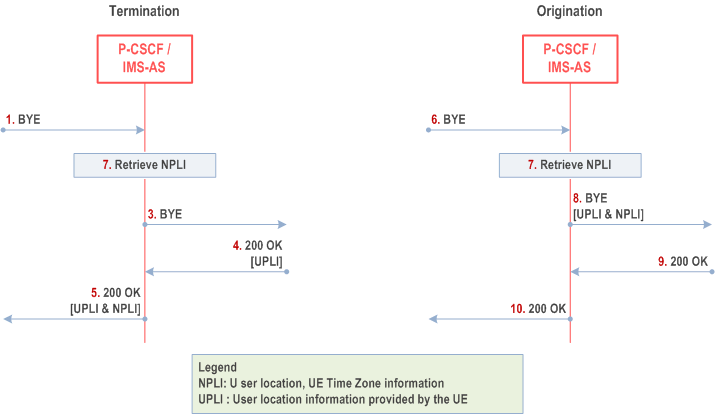
Terminating Side:
Step 1.
Originating Side:
A session release message which terminates the dialog, e.g. BYE, is received by the P-CSCF/IMS AS.
Step 2.
The P-CSCF/IMS AS invokes procedures to obtain the user location and/or UE Time Zone information from the access network. In the P-CSCF, this step will be executed together with the procedure to release corresponding QoS resources in the IP-CAN.
Step 3.
The P-CSCF/IMS AS forwards the BYE message to the UE or the S-CSCF respectively.
Step 4.
The UE/S-CSCF provides a response to the P-CSCF/IMS AS.
Step 5.
The P-CSCF/IMS AS inserts the user location and/or UE Time Zone information in the response confirmation, and this is routed towards IMS Core.
Step 6.
A session release message which terminates the dialog, e.g. BYE, is received by the P-CSCF/IMS AS.
Step 7.
The P-CSCF/IMS AS invokes procedures to obtain the user location and/or UE Time Zone information from the access network. In the P-CSCF, this step will be executed together with the procedure to release corresponding QoS resources in the IP-CAN.
Step 8.
The P-CSCF/IMS AS forwards the BYE message within IMS Core containing the user location and/or UE Time Zone information together with the user location information provided by the UE. The user location and/or UE Time Zone information may be removed or modified (e.g. to change location granularity to just indicate the serving PLMN) if routing outside the trust domain is needed.
Step 9-10.
The Session Release procedure is completed.